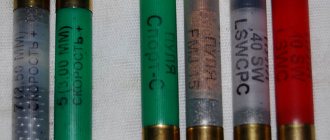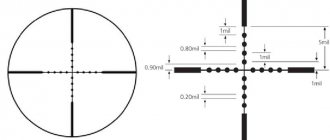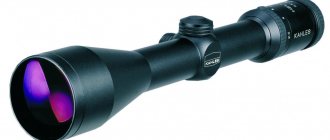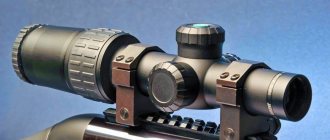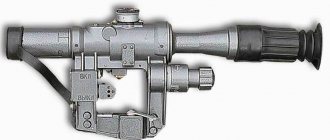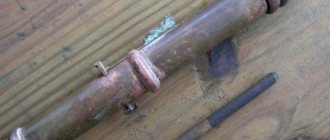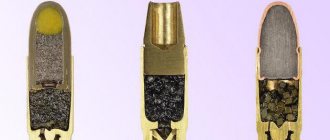Varieties
The simplest options are for driven hunting. Hunters of the old school do not use any sights at all: they prefer to shoot with the naked eye. But modern hunters, as a rule, use a special driven optical sight with a carbine: low magnification with a wide field of view. Russian sights (optical, daytime) of this type are produced by VOMZ (trademark "Pilad"), Oil Refinery (PO series).
Optical hunting sights for running hunting are also small and lightweight, but are more versatile. They can be pancratic (that is, with adjustable magnification), and have a larger lens diameter (for convenience in twilight). Illuminated reticles are also available at dusk.
As for varminting (on a small rodent, for example, a marmot, from a long distance), domestic optical sights for carbines of this type are also produced, quite large and powerful (since this type does not require mobility, and shooting is carried out from a long distance). These are similar to shooting range models.
Sights PSO, PO and POSP: unity in diversity
With all the richness of choice of modern optical sights, the constant interest of hunters and shooters is a device with a 50-year history and military career. This is a PSO - an optical sniper sight, according to some sources, originally “Ovchinnikov sniper sight” (after the name of the designer of the Novosibirsk Instrument-Making Plant).
One of the reasons for such popularity is related to the charisma of the product: a person who has chosen a conversion version of Soviet-Russian small arms - “Tiger”, as well as “Vepr” and “Saiga” - and an optical sight will try to choose the most authentic one. But the main driving force, of course, will be economic and practical considerations.
According to the Technical Specifications issued more than half a century ago, the PSO was required to have a guaranteed resource of 3 thousand rounds and another 6 thousand according to hardware reliability tests. 9,000 rounds for the owner of a sniper rifle, whatever you call it, means virtually a lifetime warranty. Even if he is not a hunter, but practices in near-sports disciplines. Still, this is not clay pigeon shooting.
In addition, after removal and installation, the PSO does not require zeroing (which was also stipulated in the technical specifications and implemented in practice). Considering the modern cost of ammunition, especially “targeted” or imported, this, you see, is an important factor.
As well as a very modest price by any standards. Since original PSOs are not available for free sale and can only be found on commission, the payment for devices decommissioned from the army is sometimes lower than the lower level, down to the traditional Russian “natural” price.
This applies mainly to the PSO-1 (4x24) version intended for SVD and its civilian version "Tiger" chambered for 7.62x54. In addition to it, the Novosibirsk Instrument-Making Plant produces PSO-1-1, PSO-1M2, PSO-2, PSO-3, intended for special weapons - VSK, VSS and others. First of all, the changes concern the mount, the sighting reticle and all adjustment and adjustment mechanisms that correspond to the ballistics of standard ammunition. In the photo - VSS "Vintorez" with a PSO-1-1 sight.
However, the only “minus” of the design, which was inherent from birth, is due to its purely military purpose – the lack of dioptric adjustment to the characteristics of vision. Indeed, it is difficult to imagine an army sniper suffering from astigmatism. But for many hunters, especially older ones, this can become a problem.
In addition, real PSOs of any series have already worked a lot in their lifetime before appearing on the civilian market. The body, mechanisms, and optics suffered. Compare the “pictures” of PSO-1 and modern civilian software 4x24.
The yellowness of the army sample is caused not only by age, but also by the use of the so-called “weaving” - glass with special additives that ensure radiation-optical stability (GOST 3514-94/76 and previous ones). But this is a completely separate topic.
In any case, if you decide to go with a completely authentic military sight, look for a “fresher” option. Otherwise, you may encounter such a seemingly trifle as searching for an ancient original battery. Compare:
But the luminescent screen installed on early versions of the sight, rechargeable from any light sources, served not only to detect sources of infrared radiation, as many believe, but also actually acted as a prototype of night vision devices, providing night recognition of targets at a distance of up to 100-150 meters. It was removed from the design just with the advent of domestic night sights. However, the time of such devices is irrevocably gone...
Therefore, if you are purchasing a sight solely for practical purposes without any trace of collecting, pay attention to the civilian versions produced by oil refineries under the general software index. In terms of strength, reliability and durability, they are practically no different from the military prototype. Yes, their tests are carried out according to a more gentle program, for example, not at -50, but at -40 degrees, but the parts, assembly lines, and workers are the same. In addition, the most extreme hunting, you see, is also different from combat.
A significant advantage of civilian sights is their wide range. There is a complete analogue of PSO-1 - PO 4x24. Like the prototype, it is designed for SVD/Tiger rifles.
The 4x24-1 software for the Saiga and Vepr carbines is designed taking into account the mounting characteristics and ballistics of ammunition.
Sights with increased magnification and lens aperture PO 6x36, 6x36-1 and 6x36-2 are installed on both the Tiger and conversion Kalashnikov carbines, as well as SKS.
Finally, the Novosibirsk team brought to the market a line of pancratic sights. In the photo is the “younger” model - 1.5-4.5x16 “Tiger”.
PO 3-9x24, intended for the "Tiger" and "Vepr", and PO 3-9x24-1 - also for the "Saiga".
All of them, like modern modifications of their military counterparts, are absolutely sealed and filled with dried nitrogen, which guarantees moisture protection and no fogging at any temperature changes. There is also no doubt about reliability and durability.
Here is an excerpt from a letter from a specialist from the Federal State Unitary Enterprise for the Oil Refinery regarding the inspection of the plant’s products:
“Many enterprises are not interested in our existing and developing sighting equipment. This is a fact and we cannot escape this.
That’s why we supply high-quality equipment that has passed all types of tests, 100% of the products.
Tests are carried out in two stages (I’m talking about civilian products now): 1. By the manufacturing workshop, bearer tests (somewhat more gentle than QCD acceptance); 2. Quality control department, acceptance and delivery. Only devices that have passed the presentation tests are used for acceptance tests.
Important characteristics tested during testing include:
Resistance to mechanical shocks. Tests are carried out on an electromechanical three-component shock installation SM-1M. Number of blows - 100 (during standard tests - 500). The following accelerations are provided:
- in the horizontal direction (parallel to the optical axis) 328g
- in vertical direction 245g
- laterally 200g
And also, MANDATORY, all 100% of products (note, not selectively from a batch, not 10%, but ALL products) are tested for the effects of: critical temperatures, shaking, precipitation, dust and sand, tightness.”
At the same time, civilian sights of the PO series have retained a utilitarian military approach to aiming technology, which is fully compliant with field conditions and does not require special skills in working with modern mil-dot reticles, ballistic calculations, etc. Of course, any military sniper, even a beginner, is not an infantry “young untrained fighter,” but still...
Without deviating from the topic of the review, briefly about the methodology, which is the same for military and civilian devices. Their reticles themselves differ only in the “conversion” reduction in the basis of the height rangefinder scale from 1.7 meters for PSO (average human height) to one and a half meters for PO (pictured).
This is what the grid looks like with the backlight turned on. In reality, of course, the sharpness is much better than in the photo.
But let’s take the well-deserved army version as a basis.
Of the really necessary explanations, it should perhaps be said that the division price of the lateral correction scale corresponds to one thousandth (0-01). The rangefinder scale starts at 200 meters (direct shot distance) and ends at 1000 meters in 100 m increments.
When shooting up to 1000 meters, using a rangefinder scale (or another method), we determine the distance to the target and enter the distance using the vertical correction drum. Its main scale is digitized in hundreds of meters, the additional one (on top) allows you to enter clarifying adjustments when aligning the sight (division value is 0.5 thousandths).
On the drum (handwheel) of lateral corrections, the scale is graduated from zero to the right and left with a division value of 1 thousandth to 10. In full accordance with the horizontal scale of the grid.
At the ends of the handwheels there is a very “school” cheat sheet: on the side - “left STP”, “right STP”, on the top - “up STP” and “down STP”.
That is, adjusting the midpoint of impact does not cause any difficulties when shooting.
As, indeed, the shooting itself from the SVD/Tiger up to three hundred meters. Both the PSO-1 and the PO series, all mechanics, including brackets, are extremely reliable and not subject to slips and displacements. The technical accuracy of the rifle and the performance characteristics of the scope make it possible to maintain accuracy within the stated 1MOA at short and medium distances.
As distances increase and when shooting at extreme levels, the influence of external factors increases, including the quality of ammunition and the skills of the shooter himself. The need for calculations arises; a ballistic table prepared in advance will not hurt.
When it comes to rangefinders with a built-in ballistic calculator and weather stations, that is, high-precision long-range shooting and mountain hunting, economic considerations begin to fade into the background. A logical continuation is the idea of changing the rifle itself to something more suitable, at least in terms of weight and dimensions.
The scope faces the same fate, since the PSO/PO is not designed to be mounted on Weaver rails or the upper dovetail. And the field advantages of metric linear units of measurement disappear when using a calculator.
In this case, the shooter has a worthy alternative - products from the Belarusian Zenit under the symbol POSP.
They are based on the same legendary PSO-1, the production of which was transferred from the refinery to the related facilities of BelOMO in the mid-80s of the last century. After well-known events, the enterprise became an independent player and, following the logic of market relations, began modernizing its products.
At first, civilian models were practically no different from the prototype. In a slightly updated version, they are still on the assembly line. In the photo there is a POSP 4x24T (T for “Tiger”).
Explanation of the signs after the names of the sights:
- B – designed for installation on carbines of the “Vepr” and “Saiga” types;
- T – designed for installation on “Tiger” type carbines;
- W - designed for installation on weapons with top-mounted guide rails such as “Weaver”, “Picatiny rail”;
- L - designed for installation on carbines “Korshun”, “Sobol”, PZh-18NM;
- L7 - designed for installation on Los-7 carbines and modifications;
- L9 - designed for installation on Los-9 carbines and modifications;
- D (D) – depending on individual vision characteristics, it is possible to adjust the eyepiece from minus 3 to plus 3 diopters;
- M – modernized rangefinder reticle;
- C – the sight provides the ability to select the brightness of the reticle illumination depending on the illumination of the area;
- Pro - the sight has the ability to more accurately aim at the target;
- Numbers 1, 2... are grid numbers.
For clarity, we provide a table of the main grids. It should be noted that a simplified version - No. 10 - is often used in sights designed for Saiga carbines. It fully allows you to solve all the problems characteristic of this weapon.
Then the much-in-demand dioptric adjustment appeared on sights (products with the letters “D/D”) and, finally, devices with increased magnification entered the market, followed by lens apertures – 6x42 and 8x42. Below is a POSP 6x42VD.
That is, it has dioptric adjustment and is intended for Vepr and Saiga carbines.
The plant gradually expanded its product range. Currently on stream there are sights for the Korshun, Sobol, Los-7 and Los-9 carbines. The photo shows the POSP 8x42 L9.
Wide-angle sights PO 4x24P2 are designed for installation on any rifles and carbines equipped with a dovetail side mount, as well as on automatic small arms. When using brackets with adapters, installation is possible on models from foreign manufacturers - Heckler & Koch Gewehr 36, M-16, FN and others.
And most importantly, devices with a mount for the universal Weaver/Picatinny rail, as well as a Mildot reticle, have finally appeared. They are designated by the letters “W” and “M”.
The photo shows a POSP 8x42 WD M6 PRO.
The vertical corrections for such sights are entered not in conventional hundreds of meters, but in modern “clicks” (2.5 cm per 100 m). Now the problem of compatibility with imported ballistic calculators has disappeared by itself.
Thus, the factory program now contains all the main types of sighting reticles, from the classic SVD (and its other variant with a rangefinder “parabola” shifted down) to the “Mildot”, which has already become familiar with imported sights.
The next step of Zenit was the release of pankratic sights with variable magnification. From POSP 2.5-5×24 and POSP 2-6x24 (pictured)…
...to the flagship of the POSP 4-12x42 W M6 Pro line.
The production line also includes not very numerous models with a laser designator. Such as POSP 8x42 V with LCC-OM.
They are intended for Vepr and Saiga carbines and greatly facilitate aiming at short and medium distances.
As you can see, the range of civilian products among Belarusians is much wider than that of oil refineries. Quality and reliability are also okay. Created as part of the leading republican production association in 1973, the plant managed to gain momentum and accumulate significant experience even before the collapse of the Union. And then he even managed to get a head start over his Russian colleagues. Do not forget that the domestic military-industrial complex began to revive literally in recent years, while in the fraternal republic the problems of military development and the defense industry have always been given increased attention.
Now the opportunity to get a head start appears at the Novosibirsk Instrument-Making Plant. The entire might of the Soviet defense industry was behind the development of the PSO series sights. Designers, technologists and mathematicians from renowned design bureaus, SKTB and research institutes took part in it. The absolute majority of them remained on Russian territory. Many, along with refineries, recently became part of the largest holding JSC Shvabe and are now reviving the Russian weapons school at an accelerated pace.
By fastenings
Different weapons require different mounting methods. For example, optical sights for the SVD (Tiger carbine) and other models - analogues of Soviet army weapons of the Dragunov and Kalashnikov systems use a side dovetail mount. Imported carbines usually have a Weaver or Picatinny type top mount. Optical (hunting) sights are sold without a bracket included and can be installed on a bracket purchased separately.
Using the scope
Mounting the sight
To install the sight on a weapon, you need to install the sight on the seat and move the clamping screw handle
.
On SVD-type rifles, after installing the PSO-1 optical sight, it remains possible to use a mechanical sight
, since the sight, when installed on the mount, is shifted to the left and does not overlap the mechanical sight.
Removing the sight
The PSO-1 sight can be removed from the rifle and attached to it without reducing the quality of shooting. the handle of the clamping screw towards you.
and remove the sight from the dovetail towards the butt.
Determining the range to the target
The PSO-1 optical sniper sight has a distance determination scale tied to the average human height of 170 cm.
According to the rangefinder scale
The distance to an object can be determined using a rangefinder scale. The rangefinder scale shows marks from 10 to 2. By aiming the sight so that the object is placed between the upper line of the mark and the lower horizontal line, you can determine the range to the target. In the picture on the right, for example, the range to target D
=400 meters.
On the scale of lateral corrections and angular values using the thousandth formula
Example
: We observe the chest target.
Target size B
= 0.5 m, angle
Y
= 0-01 = 1. To calculate range
D
, target size
B
is multiplied by 1000 and divided by the angle in thousandths
Y
:
D=(0.5×1000)/1=500
By grid
The grid can be simple or complex; stores sell optical sights for carbines with different types of reticle. Corrals, as a rule, use a simple mesh like “stump” or “three stumps”. For the chassis, variations of the “Cross” type mesh (LD, LK, MilDot) are often used.
As for varmint and other types of slow-moving long-distance hunting, military-style reticles are usually used, with rangefinders, parabolas and other special devices to facilitate aiming).
Night
The leader in the Russian market (Novosibirsk). It has occupied a large part of the market, and only occasionally you can find old “Baygysh” and other companies on sale secondhand.
Night optical sights for SVD are produced with the same mount as day ones; the same applies to other models of carbines and rifles.
Nocturnal ones vary by generation. There are three main generations (1, 2, 3), but intermediate generations are also distinguished (1+, 2+, 3+). The main generations differ in technical characteristics: the first generation allows observation at a fairly short distance, weakly amplifies the light and gives a somewhat “blurred” picture, the second - allows you to aim at a greater distance, the third - an almost unlimited distance, a clear picture and any degree of light amplification up to up to x100000.
Intermediate generations differ from the main ones in a greater degree of compactness and various additional options (for example, an anti-light system).
Sight device
PSO-1 device:
1-eyecup; 2-eyepiece; 3-screws; 4-flywheels; 5-body with mounting bracket; 6-lens; 7-backlight switch; 8-clamp screw; 9-adjusting nut; 10-clamp; 11-power compartment cover
The optical sight consists of a mechanical
and
optical
parts.
Mechanical part
The mechanical part of the sight includes:
- frame;
- top and side handwheels;
- sight reticle lighting device;
- retractable lens hood;
- rubber eyecup and cap.
Frame
serves to connect all parts of the sight on the rifle. The bracket has grooves, a stop, a clamping screw, a clamping screw handle, a slider with a spring and an adjusting nut. Pointers (indices) for sight settings and lateral corrections and a lens cap are attached to the body.
View through the PSO-1 sight mounted on the SVD rifle. Upper handwheel
serves to install the sight,
the side handwheel
is used to introduce lateral corrections. They are identical in design and have a handwheel housing, a spring washer, an end nut and a connecting (central) screw. There are three holes on top of each handwheel: the middle one is for the connecting screw, the two outer ones are for the locking screws.
The spring washer serves to hold the handwheel in position.
Mesh lighting device
serves to illuminate the sight reticle when shooting at dusk and at night. It consists of: a housing with a contact screw, a battery that serves as a current source, a cap with a stop and a spring for pressing the battery to the screw, wires connecting the screw (battery) to the light bulb through a toggle switch, a toggle switch for turning the light bulb on and off.
The battery is installed in the case so that the central electrode is connected to the screw, and the side electrode (displaced to the side) is connected to the case; To do this, the contact plate of the side electrode is bent over the edge of the housing, after which the cap is put on.
Eyecup
(rubber) is designed for correct installation of the eye and ease of aiming. In addition, it protects the eyepiece lenses from contamination and damage and prevents the appearance of light glare from the eyepiece lens, which illuminates the visual field and tires the shooter’s vision.
Retractable hood
serves to protect the objective lenses in inclement weather from rain, snow, as well as from direct sunlight when shooting against the sun, thereby eliminating reflections that unmask the sniper.
Rubber cap
Protects lens lenses from contamination and damage.
Optical part
PSO-1 sighting reticle
The optical part of the sight includes:
- lens;
- wrapping system;
- sight reticle;
- fluorescent screen;
- eyepiece.
Lens
serves to obtain a reduced and inverted image of the observed object. It consists of three lenses, two of which are glued.
Wrapping system
designed to give the image a normal (straight) position; it consists of four lenses glued in pairs.
Sight reticle
serves for aiming; it is made on glass mounted in a movable frame (carriage).
The following are marked on the sight reticle:
- main (upper) square for aiming when shooting up to 1000 m;
- lateral correction scale;
- additional squares (below the lateral correction scale along the vertical line) for aiming when shooting at 1100, 1200 and 1300 m;
- rangefinder scale (solid horizontal and curved dotted lines).
Fluorescent screen
serves to detect infrared light sources; it is a thin plate of a special chemical composition, which is laid between two glasses. The screen has a window with a light filter in the frame for charging the screen and a flag for switching the screen: towards the light filter (horizontal position of the flag) - for recharging the screen and when shooting under normal conditions; towards the lens (vertical position of the flag) - when observing and shooting at targets that detect themselves by infrared radiation.
Eyepiece
designed to view the observed object in an enlarged and direct image; it consists of three lenses, two of which are glued.
For pneumatics
Catching small game with pneumatics, despite its dubious legal status, is practiced in Russia. However, pneumatic weapons differ in specific characteristics associated with the special ballistics of air weapons.
A bullet from an air rifle usually flies along a less flat trajectory than from a firearm. For this reason, without rangefinders and distance correction scales, they can be used on pneumatic rifles only for shooting at close ranges. A special pneumatic sight - with a low magnification and at the same time with a complex reticle with a rangefinder.
These types of sights are produced by all the same companies that make regular day sights for firearms.

